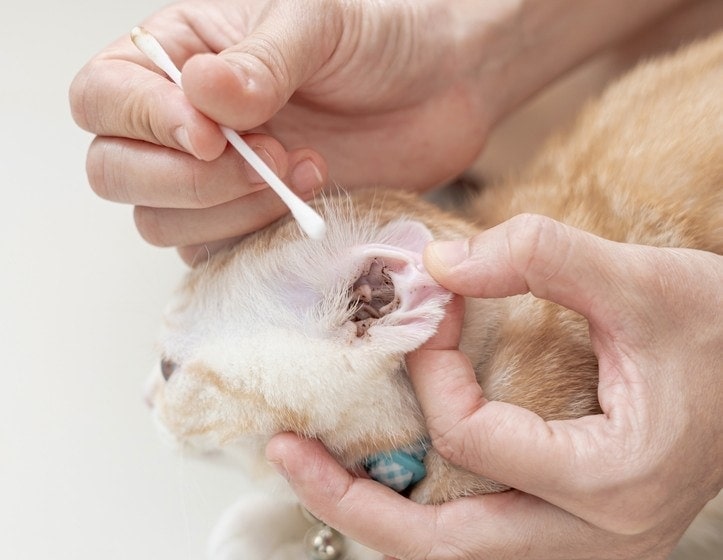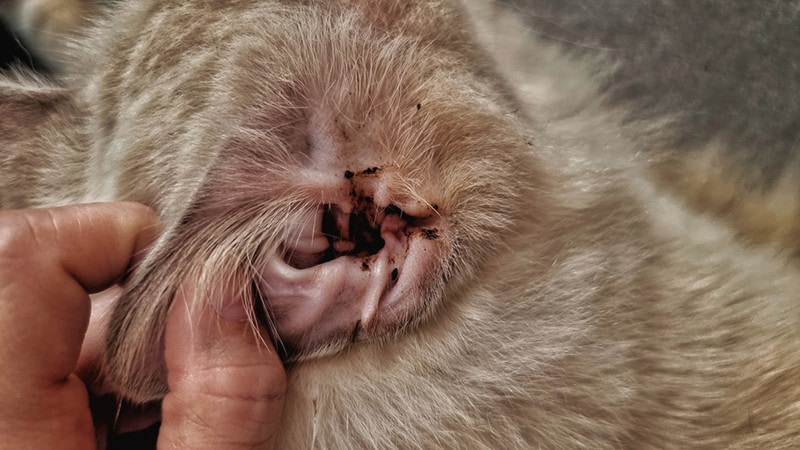
Click to Skip Ahead
Cats aren’t as well known for goofily thumping at their ears the way their canine compatriots are. What’s worse is they tend to sleep one night with no issues and wake up the next day, seemingly missing the skin off the back of their ears from scratching! What could possibly possess a cat to scratch so much that they cut open their skin leaving it raw and bleeding?
Unfortunately, a cat scratching their ears could happen for many reasons, some more likely to be this bad than others. We’ll go over what you need to understand about your cat’s ears, what might cause them to scratch to the point of causing trauma, and how to care for your itchy cat so they can get some relief!
Cat Ear Anatomy

A cat’s ears have three basic parts: the outer, middle, and inner ear.
The outer ear is made up of the pinna and ear canal. The external ear flap of the ear is also known as the pinna; it has a non-haired inner aspect and a haired outer aspect. The ear canal ends at the eardrum. The part of the ear most commonly damaged due to scratching when a cat’s ear is itchy is the pinna.
The middle ear consists of the eardrum, also known as the tympanic membrane, which as the name suggests is a tight membrane that vibrates due to sound waves, and small bones on the inside of the membrane that can transmit those vibrations to the inner ear.
The inner ear has small structures and nerves that can take the vibration information from the middle ear and send that to the brain. These same sensitive structures and nerves are responsible for a cat’s balance and awareness of where their body is in space and in relation to gravity.
 The 10 Reasons Why Cats Scratch Their Ears?
The 10 Reasons Why Cats Scratch Their Ears?
1. Mites

There are three mites that can be responsible for itchy cat ears: Sarcoptes scabiei, Demodex, or Otodectes cynotis.
Most healthy cats do not develop demodex since they are supposed to be there. An overgrowth of demodex mites on a cat, called demodicosis, is usually associated with immunosuppression, and cats with FIV, FeLV, or significant illness are most at risk.
These mites can be treated with mite-specific treatments, often with as little as one application of medication at the veterinary clinic. For cats that also develop an ear infection, especially common if they have scratched themselves raw or have ear mites, treatment of their wounds and ear infection are also needed.
2. Ringworm
Ringworm is a highly contagious fungal infection that often spreads throughout cats in shelter settings. Ringworm can also spread to dogs, people, and other mammals. Not all ringworm lesions are itchy, but it does cause hair loss, and skin that is also scratched is at risk of trauma.
Ringworm can be diagnosed at the veterinary office, and antifungal medication, likely oral and topical, can be prescribed for affected cats.
3. Fleas

Another super contagious cause of itching in cats, these are usually found all over an infected cat with signs like hair loss and scratching anywhere on their body. Not only can fleas cause bleeding from scratches, but fleas ingest blood from the cat’s skin, and severe infestations can cause anemia.
Fleas can spread between cats and dogs and can bite humans, but do not infect humans. There are over-the-counter flea medications and treatments, but it is best to see your veterinarian to screen your cat for tapeworms, which are transmitted by fleas, anemia, and for safer, more effective prescription flea medications. Treating flea infestations often requires several months of extensive treatment, potentially utilizing multiple flea medications, and can be very time and cost-intensive. It is best to keep your cat on a monthly flea preventative to avoid this issue entirely.
4. Allergies
Overgrooming, hair loss, and scratching the skin raw are hallmark signs of allergies in a cat. They can also develop ear or skin infections secondary to self-trauma and generalized allergy inflammation.
Allergies in cats can be tricky to treat. There are different types of allergies, like environmental versus food allergies, which can show the exact same signs. Cats are also notoriously picky and may not tolerate a diet change, nor are they easy to give medication to in most cases, making daily allergy medication difficult, if not dangerous. Your veterinarian can perform a full workup to narrow down the source of your cat’s allergies and the best way to treat them.
5. Infection

Skin infections can be bacterial or yeast and can arise for several reasons, sometimes even secondary to other causes of itching already on this list.
Ear infections are a common cause of ear scratching in cats, which can leave them not only scratched raw but with burst internal blood vessels that cause the ear pinna to swell.
External ear infections of the outer ear are the most common and are what you think of when you think of an ear infection. These are bacterial and/or yeast infections of the ear canal that cause odor, discharge, debris, pain, scratching, and head shaking.
Middle and inner ear infections are less common but can have significant signs such as a head tilt or difficulty standing and moving straight, nausea, vomiting, and decreased appetite. These infections, if lacking an external ear infection, are less likely to be itchy.
Antibiotics or antifungals can treat these infections. Sometimes they are given directly into the ear; sometimes, they are given by mouth or injection, or some combination thereof, based on the needs of the cat.
6. Foreign Body
As you can imagine, there is nothing comfortable about getting something stuck in your ear. The most likely culprit for an inner ear foreign body in a cat is a grass awn or foxtail, which is a grass seed that is specifically good at getting caught in an animal’s coat and on their body. These can find their way into the ear and have sharp edges and stick in place and move forward through the ear canal. They’re painful, and itchy, and a cat with one in their ear will usually be unable to stop violently shaking their head and scratching their ear.
A cat with a foxtail or anything else stuck in their ear canal needs to see a veterinarian to have it removed under sedation before they have a chance to hurt themselves.
7. Polyps and Tumors

Cats can develop different types of growth in their ears. Some are more common in certain breeds or exposure to the sun or if there has been inflammation or infections in the ear canal chronically. Others we don’t always know the cause of. These abnormal growths can lead to new ear infections and general attention to the ear that can result in raw ears from rubbing, scratching, and infections.
These small growths can often be treated with surgery or even cryotherapy, though; unfortunately, some metastatic tumors may not have treatment options.
8. Ceruminous Cystomatosis
Speaking of growths in the ear canal, cats have a syndrome known as ceruminous cystomatosis, where they can, in a rare case, begin to make pinpoint to raisin sized, dark purple/gray cystic growths in their ear in abundance. These are usually found on the pinna and ear canal and usually have no signs of a problem when small, but if large can cause ear infections which can come with intense itching.
If enough or large enough cysts develop, these can be treated in several ways, similar to other growths in the ear canal, which include surgery, cryotherapy, laser, cautery, and more.
9. Anatomy

I know; we already discussed anatomy once. How much more could we want to talk about this subject? The reason this is our focus again is because some cat breeds are more prone to itchy ears than others. In particular, Scottish Folds are the only cat breed that has down ears rather than up. These are prone to developing ear infections, as are the ears of any cats that have had significant trauma that caused their pinna to fold or shrivel.
Regular ear cleanings can help keep these cats from scratching at their ears too much.
10. Trauma
Cats that have scabs on their ears from scratches from other animals or running through sharp foliage are susceptible to continuing to scratch the itchy scabs. They can create a problem where they continue to scratch and don’t allow the area to heal, even opening the skin deeper or causing ear infections.
If your cat is struggling with this, getting them into an e-collar until their ear fully heals, usually at least two weeks, will solve this problem.
How Do I Care for a Cat That Has Scratched Their Ears Raw?
After taking your kitty to a vet to diagnose the underlying cause of the scratching, you’ll have some supportive care you can do from home to help keep them comfortable.
In most cases, your cat will benefit from wearing an e-collar to keep them from scratching further, which will greatly improve their healing time.
You’ll want to encourage them to rest as best as you can tell a cat to do anything and keep them out of the water as they need to stay dry until everything heals up outside of potential flea baths.
Be sure to confirm whether your cat has a contagious condition and, if so, to which species so you can quarantine appropriately and seek medical care yourself if needed.
Conclusion
While cats scratching their ears raw can seem scary and intense, the cause is often everyday things like ear infections. As soon as you note any signs of itchy ears or see any trauma, contact your veterinary team so they can help get to the bottom of the cause and get you what you need for your cat to feel better!
Featured Image Credit: FOX, Pexels







